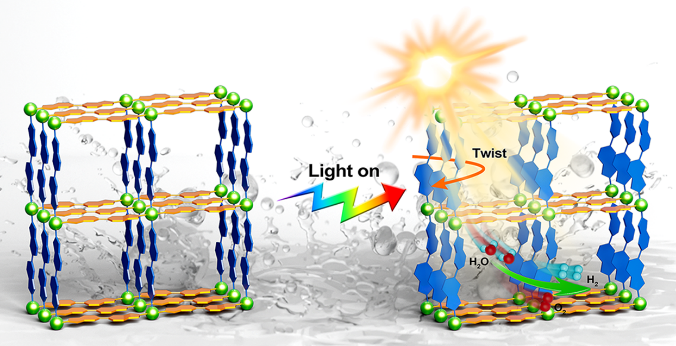A research team led by Prof. JIANG Hailong, Prof. LUO Yi, and Prof. JIANG Jun from the University of Science and Technology of China (USTC) discovered a metal-organic framework (MOF) that suppress charge recombination, which is a major challenge in photocatalytic overall water splitting. Their study was published in Nature Chemistry.
Photocatalytic overall water splitting for hydrogen production is considered the "Holy Grail" reaction of chemistry. However, a major challenge in this reaction is preventing the recombination of electrons and holes. Traditional strategies to suppress the recombination mainly focus on the ground-state structure of the catalyst, while the electron-hole recombination occurs in the excited state.
Inspired by natural photosynthesis, where proteins undergo conformational changes to stabilize electron transfer, the research team developed a new approach based on the excited-state structural changes that artificial photocatalyst goes through upon receiving electrons. The team selected an MOF known as CFA-Zn, which is composed of closed-shell Zn2+ nodes connected by two chemically identical but crystallographically independent flexible organic linkers. These linkers act as electron donor-acceptor pairs, while the closed-shell structure of Zn2+ ensures chemical insulation between the linkers. This unique configuration allows CFA-Zn to create a dynamic, flexible microenvironment similar to that in plant cells. Upon photoexcitation, CFA-Zn undergoes a structural twist that stabilizes the excited-state electrons, prolonging their lifetime and enabling efficient overall water splitting.

Photocatalytic overall water splitting through excited-state structural twist of MOF. (Image by SUN Kang et al.)
In previous work, Prof. JIANG Hailong's team had made a series of advances in regulating the microenvironment around catalytic centers. Notably, they utilized the flexible structures of MOF catalysts to create adaptive catalytic sites, achieving high selectivity in CO2 photoreduction to CH4. Building on this foundation, this new study employed a dynamic structural MOF photocatalyst that suppresses radiative relaxation, demonstrating application potential for diverse photochemical processes beyond overall water splitting. The work has received high praise from the reviewers, who described it as "a novel and disruptive concept" and "an exciting development" towards more efficient photocatalysts.
Paper link: https://doi.org/10.1038/s41557-024-01599-6
(Written by CHEN Yehong, edited by ZHANG Yihang, USTC News Center)